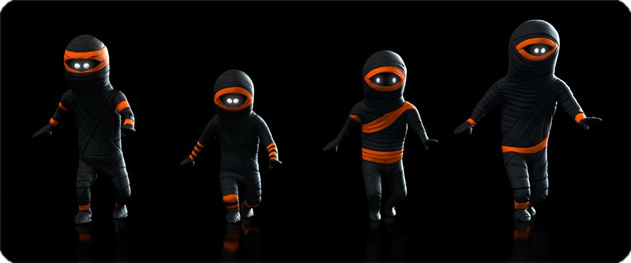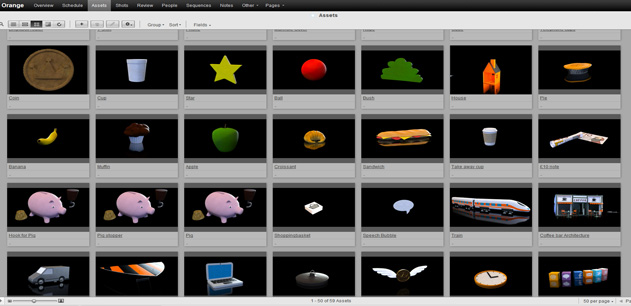
The Orange Ninja’s job has turned into a fantastic project, and a really good example of how Kettle can apply a knowledge of cross-media and joined-up-thinking to create a win-win situation for clients.
The story starts a long time back, on a different project altogether..... Kettle were approached by
The Marketing Store Worldwide [TSMW] to help them with a thorny problem relating to McDonalds. McDonald's main agency had introduced their new european flagpole character ‘Happy’ - beautifully realised and rendered he was too. The problem was that the rights to this character were retained by the French production company that produced him, and their costs were too high for the large quantity, rapid turnaround work that TSMW and the other McDonalds partners needed.

TMSW approached us to help. TSMW cleared the legalities and we set about recreating a fully rigged (the process of preparing a model for animation) Happy in a like for like basis, with the end result of selling a rights free model that TSMW and others could use for any purpose they required. We made sure the model was packaged up and documented in as simple a way as possible (3d can get pretty damn complex if you’re not careful), so the end agencies could whack out a pose or animation, hit render and be ready to roll. In the end our Happy appeared all over the place, in print, on-line and in several high profile commercials.
Scrub back to the beginning of the year and we’d been working with
Fallon on a few jobs. They approached us with a loose idea of creating a new ‘library’ for Orange, based on a new campaign about to break - the Ninjas. The ninjas and any associated props were to be designed and made by
Wilfred Wood, a very talented artist / sculptor.
Their previous campaign, utilising beautiful models from
Crissie MacDonald revolved around Chrissie making the models, getting an ATL shoot done with the photographer (
John Short) and then finally a more generic shoot of the models so they could be uploaded to a library for all the other Orange agencies / suppliers to use. The problem with this approach was that these were static images - meaning if you needed a different angle or animation? Tough. You re-create in 3d, or do it in stop motion - both time consuming and expensive.
It was clear that the best approach here was to deliver actual 3d files, ready to go ‘out of the box’.
We worked through the process with Fallon - How can we make them as simple to use as possible? What software should they be produced in? What are the logistical issues? How do we keep quality assurance? How do we keep costs down?
For dealing with logistics It was decided early on the there should be a main ‘area’ or hub that all models would be accessible from, so any Agency or supplier would be able to get access to any model or prop commission, regardless of who commissioned it - share and share alike.

We proposed that we deliver the four initial Ninjas and a supporting lighting scene, setup and ready to go. All models were produced with large scale print resolutions in mind, as this made sure that any models or props produced would stand up to scrutiny in all and any formats (print resolution is always the biggest output, so anything smaller: tv, digital is not an issue). This process was fully documented and the entire Maya project made available to all the associated agencies and suppliers. By providing the supporting lighting scene (which was quite locked down) we were able to reinforce the quality control - the end agencies knew where the ninja’s needed to be, what angles were valid, what settings to use, what was acceptable, what was not. It was a simple case of posing the ninja and away you go...
We were also tasked with the production of all props. An agency would brief Fallon on the requirement, Wilfred produced a sketch, and we realised the prop in 3D. The prop would then be placed on the hub to be downloaded and used by any of the Orange agencies / suppliers.
The end software choice was Maya. This was chosen because of its installed user base, and availability of operators. Many packages were reviewed (Cinema4D was popular with the agencies, but its ability to produce truly photorealistic renders in an acceptable time-frame was limited. Softimage was discussed as it’s our internal package of choice but the user base deemed too small. The final decision was between Maya / 3DS Max, with Maya winning through).

Each ninja and prop was produced for a set all in cost, so Fallon and in turn Orange knew the costs associated with the approach, there were no nasty surprises later down the line.
Five months later and the project is still going strong. It’s a joy to see the ninja’s being independently realised - the constant stream of images adorning Orange shop fronts, the metro, the tube escalators, all being formed from our base files. It’s also a testimony to the work done that, although not officially giving support, the documentation did include contact details should folk need help (3d can be a tricky mistress): In the five or so months the project has been running we’ve received three calls for help. Three.
The assets we created have been used across all media both above and below the line. We've created online animations, banner ads, online and traditional print, press and out of home media.
Long live the ninja’s. They’re cute little fellas.